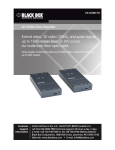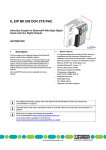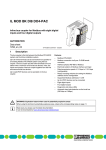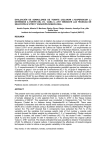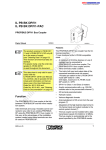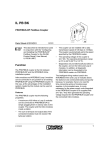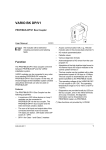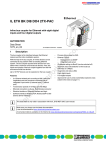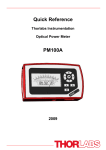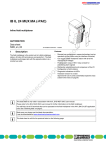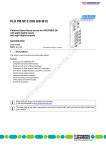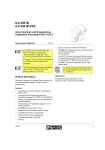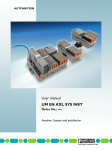Download IL DN BK DI8 DO4-PAC - Onlinecomponents.com
Transcript
IL DN BK DI8 DO4-PAC I2 PA O4I8 D K D 97211 NB IL D -No.: 28 er Ord C O1 2 3 4 5 6 7 8 9 N 10 Inline Bus Coupler for DeviceNet™ With 8 Digital Inputs and 4 Digital Outputs I1 O1 PWR NT UL D M US N R UM E 2 1 4 3 2 1 4 3 7 5 8 6 Data Sheet 7523_en_00 © PHOENIX CONTACT - 11/2007 Module Features om DeviceNet™ connection via TWIN COMBICON connector DIP switch to set the DeviceNet™ address Supported DeviceNet™ addresses 0 to 63 Device description using EDS file 8 digital inputs 4 digital outputs Diagnostic and status indicators Automatic baud rate identification in the local bus (500 kbps or 2 Mbps) in ec – – – – – – – – co DeviceNet™ Features – – – Faulted node recovery Baud rates: 125 kBaud, 250 kBaud, 500 kBaud I/O slave messages: Polling, Cyclic, Change-of-State (COS), Bit strobing on l – – – – po With the help of a bus coupler, 63 Inline terminals can be connected at any position within an existing DeviceNet™ system. The bus coupler and the Inline terminals together build a station with 63 local bus devices. Here, the inputs and outputs of the bus coupler together form the first local bus device. ne The IL DN BK DI8 DO4-PAC bus coupler is the interface between the DeviceNet™ and the Inline installation system. Connection of up to 63 I/O modules Can be installed in the field without software for automatic configuration of the station Digital inputs with latch function Stored (latched) diagnostic data Reservation of I/O memory area for future expansions possible (no hardware required) Supported Inline module types: Digital inputs and outputs Analog inputs and outputs Intelligent function modules s. – – Description nt 1 m AUTOMATION This data sheet only is valid in connection with the IL SYS INST UM E user manual (see "Ordering Data" on page 2). Make sure you always use the latest documentation. It can be downloaded at www.download.phoenixcontact.com. A conversion table is available on the Internet at www.download.phoenixcontact.com/general/7000_en_00.pdf. This data sheet is valid for all products listed on the following page: IL DN BK DI8 DO4-PAC 2 Ordering Data Product Description Order No. Pcs./Pkt IL DN BK DI8 DO4-PAC 2897211 1 Accessories Description Type Order No. Pcs./Pkt DeviceNet™ connector TMSTBP 2,5/ 5-STF-5,08 GNAU CP 2862576 1 Connector set as replacement item IL BKDIO-PLSET 2878599 1 Extended double signal connector for inputs, 4 signals with 3-wire connection method IB IL SCN-12-ICP 2727611 10 Extended double signal connector for outputs, 4 signals with 3-wire connection method IB IL SCN-12-OCP m Type 2727624 10 co Inline bus coupler for DeviceNet™ with 8 digital inputs and 4 digital outputs including accessories (end plate, connector and labeling fields) IL CP ZB 6 ... see CLIPLINE catalog 2742683 100 1051003 10 ZB 12 ... see CLIPLINE catalog 0812120 10 NS 35/7,5 PERFORATED NS 35/7,5 UNPERFORATED 0801733 0801681 1 1 End clamp CLIPFIX 35-5 3022276 50 Type Order No. Pcs./Pkt UM EN IL DN BK DI8 DO4-PAC 2910334 1 AH IL BK IO LIST 9015358 1 IL SYS INST UM E 2698737 1 s. Zack marker strip to label the terminals DIN EN 50022 rail, 2 meters nt Keying profile Zack marker strip to label the terminals User Manual: "IL DN BK DI8 DO4-PAC Bus Coupler" Application Note: "I/O Modules at Bus Couplers" User Manual: on l in ec om "Automation Terminals of the Inline Product Range" po ne Documentation Description 7523_en_00 PHOENIX CONTACT 2 IL DN BK DI8 DO4-PAC 3 Technical Data General Data Housing dimensions (width x height x depth) 80 mm x 121 mm x 70 mm Weight 255 g (with connectors) Ambient temperatures (operation) -25°C to +60°C Ambient temperature (storage/transport) -25°C to +85°C Permissible humidity (operation/storage/transport) 10% to 95%, according to EN 61131-2 Permissible air pressure (operation/storage/transport) 70 kPa to 106 kPa (up to 3000 m above sea level) Degree of protection IP20 according to IEC 60529 Class of protection Class 3 in acc. with VDE 0106, IEC 60536 m Connection data for Inline connectors Spring-cage terminals Conductor cross-section 0.2 mm2 to 1.5 mm2 (solid or stranded), 24 - 16 AWG co Connection type DeviceNet™ System Data 500 kbps, 250 kbps, 125 kbps s. Transmission speed CR check Maximum transmission distance Up to 500 m (depends on transmission speed) Protocols Control and information (Common Industrial Protocol) with CAN as transport medium nt Transmission reliability 64, max. ne Nodes Voltage range of the bus coupler (+V, -V) 11 V - 25 V Nominal current of the bus coupler (+V, -V) 60 mA ODVA po Bus coupler certification System Limits of Bus Coupler Number of I/O devices within an Inline system Maximum number of process data Maximum number of PCP devices in ec Maximum power supply at UL (7.5 V) 500 kbps or 2 Mbps (automatic detection) om Transmission rate on the local bus 63, max. Limited by Class-Instance maximums Observe the 2 byte status data of the bus coupler. 8 0.8 A, max. Maximum power supply at UANA 0.5 A, max. Maximum power supply at US 8 A, max. (total current with UM) Maximum power supply at UM 8 A, max. (total current with US) See terminal-specific data sheet on l Maximum current consumption of the I/O terminals Observe the current consumption of each device when configuring an Inline station. The current consumption is indicated in each terminalspecific data sheet. The current consumption can differ depending on the individual terminal. If the maximum current capacity of a power supply is reached, a new power terminal must be used. DeviceNet™ Interface CAN bus, connected via TWIN COMBICON connector Common Data for 24 V Supply UL, US, UM Connection Via power connector; for terminal point assignment see page 10 Connection method Spring-cage terminals Recommended cable lengths 30 m, max.; routing cables through outdoor areas is not admissible Continued Via potential routing Nominal value 24 V DC Tolerance -15%/+20% (according to EN 61131-2) Ripple ± 5% Permissible range (according to EN 61131-2) 19.2 V to 30 V 7523_en_00 PHOENIX CONTACT 3 IL DN BK DI8 DO4-PAC Common Data for 24 V Supply UL, US, UM (Continued) Safety equipment Surge voltage, polarity reversal Yes, suppressor diode parallel to supply voltage NOTE: The bus coppler is damaged in the event of overload The 24 V area must be protected externally. The power supply unit must be able to supply 4 times the nominal current of the external fuse, to ensure that it trips in the event of an error. Recommended fuse 4 A medium blow. UL (7.5 V) and UANA (24 V) are generated from UL (24 V). m Current Consumption / Power Consumption 0.4 A, max. Current consumption from UANALOG (24 V) 0.5 A, max. 0.9 A, max. 8 A, max. Current consumption from UM (24 V) 8 A, max. Power dissipation entire device 3.5 W, max. Digital Outputs 4 ne Number nt Current consumption from ULOGIC total Current consumption from US (24 V) s. Current consumption local bus (800 mA load at 7.5 V) co Current consumption from ULOGIC (24 V) Connection method for actuators 2 and 3-wire technology 24 V DC Nominal output voltage UOUT < 1V po Differential voltage for Inom Nominal current Inom per channel 0.5 A Total current 2A Ohmic Lamp Inductive Response time Overload response in ec Switching frequency with nominal inductive load om Nominal load 12 W 12 W 12 VA (1.2 H) 0.5 Hz (1.2 H), maximum 1.2 ms, typical Auto restart Response with inductive overload Output may be damaged Reverse voltage protection against short pulses Protected against reverse voltages on l Resistance to permanently applied reverse voltages Response upon power down Protected against reverse voltages, permissible current 2A, maximum The output follows the supply voltage without delay Limitation of the voltage induced on circuit interruption -30.0 V, approximately Safety equipment Short circuit; overload Type of safety equipment Integrated free running circuit in the output chip Maximum output current when switched off 10 µA Error message to the higher-level control system Short circuit; overload When not loaded, a voltage can be measured even at an output that is not set. 7523_en_00 PHOENIX CONTACT 4 IL DN BK DI8 DO4-PAC Digital Inputs Number 8 Connection method for sensors 2 and 3-wire technology Input design According to EN 61131-2, type 1 Switching threshold definition Maximum low-level voltage ULmax < 5 V Minimum high-level voltage UHmin > 15 V Common potentials Sensor supply US, ground Nominal input voltage UIN 24 V DC Permissible range -30 V < UIN < +30 V DC Nominal input current for UIN 3 mA, typical Limited to a 3 mA, maximum Delay time 1.2 ms, typical m Current flow 100 m Use of AC sensors AC sensors in the voltage range < UIN are limited in application co Permissible cable length to the sensor Polarity reversal Type of safety equipment Serial diode for polarity reversal protection Error message to the higher-level control system Sensor supply not present s. Safety equipment 5g load, 2 hours in each space direction ne Vibration test sinusoidal vibrations according to IEC 60068-2-6; EN 60068-2-6 nt Mechanical Requirements Shock test according to IEC 60068-2-27; EN 60068-2-27 25 g load for 11 ms, half sinusoidal wave, 3 shocks in each space direction and orientation po Conformance With EMC Directive 89/336/EEC or 2004/108/EG Noise Immunity Test According to EN 61000-6-2 EN 61000-4-2/ IEC 61000-4-2 Electromagnetic fields EN 61000-4-3 IEC 61000-4-3 Criterion A Field strength: 10 V/m Fast transients (burst) EN 61000-4-4/ IEC 61000-4-4 Criterion A All interfaces: 1 kV in ec om Electrostatic discharge (ESD) on l Surge voltage Conducted interference Criterion B 6 kV contact discharge 8 kV air discharge Criterion B All interfaces: 2 kV EN 61000-4-5/ IEC 61000-4-5 Criterion B Supply cables DC: 0.5 kV / 1 kV (symmetrical/asymmetrical) fieldbus cable shield 1 kV EN 61000-4-6 IEC 61000-4-6 Criterion A Test voltage 10 V Noise Emission Test According to EN 61000-6-4 Noise emission of housing EN 55011 Class A Approvals Information on latest approvals can be found on the Internet at www.download.phoenixcontact.com or www.eshop.phoenixcontact.com. 7523_en_00 PHOENIX CONTACT 5 IL DN BK DI8 DO4-PAC 4 Local Diagnostic and Status Indicators DeviceNet PWR TM I2 PWR BF DIA UL NT US MD UM RN 5 6 7 8 I2 I2 C 4-PA DO DI8 1 BK 9721 IL DNr-No.: 28 Orde I1 O1 O1 2 3 4 5 6 7 8 9 N 10 PWR NT UL MD US RN UM E 2 1 4 3 2 1 4 3 7 5 8 6 I1 O1 s. O1 ne Description of the LED States 24 V bus coupler supply / 7.5 logic voltage is present (ULogic) 24 V bus coupler supply / 7.5 logic voltage is not present 24 V supply of the segment circuit (USegment) is present 24 V supply of the segment circuit is not present 24 V supply of the main circuit (UMain) is present 24 V supply of the main circuit is not present Network status Device is online and has established a connection Group 2 devices are assigned to a master Error preventing communication with the network (e.g., bus is offline or duplicate MAC ID). Device online, connections not established. in ec om LED Color Meaning State PWR, DeviceNet™ UL Green ULogic ON OFF US Green USegment ON OFF ON UM Green UMain OFF NT Green/ Network red status Green ON nt Displays on the bus coupler po Figure 1 co I1 E 1 2 3 4 m 1 2 3 4 Red ON on l Green flashing Red flashing Red-green flashing OFF Device has finished the "duplicate MAC ID" test but has not established connections to other nodes. Group 2 devices are not assigned to a master. One or more connections are in the timeout state Network access error Device not online The device has not yet finished the "duplicate MAC ID" test. The device is not supplied with voltage. 7523_en_00 PHOENIX CONTACT 6 IL DN BK DI8 DO4-PAC Description of the LED States Device status (Module Diagnostics) Normal operation Unrecoverable error – Device not configured, or device configuration not complete or faulty. – Device in standby mode Recoverable error Selftest RN Green Run "Module Change" alarm during startup Connection error Loop diagnostics (e.g., for connected FLM or AS-i modules) "Module Change" alarm during operation Configuration error (without other error) Operation with error data Peripheral fault (without other errors) O1 E Red 1-4 Yellow I1, I2 E Red 1-8 Yellow 7523_en_00 in ec om po Green ON Green flashing 10 Hz 1 x Green flashing 2 x Green flashing Green flashing 20 Hz 3 x Green flashing Green flashing 1 Hz 4 x Green flashing Green flashing 2 Hz 5 x Green flashing OFF No supply voltage Status of the local Inline communication Local bus communication present Initialization phase m Red flashing Red-green flashing OFF co Green ON Red ON Green flashing s. Meaning State nt Color Green/ red ne LED MD Error ON on l OFF Output 1 to ON Output 4 OFF Error ON OFF Input 1 to Input 8 ON OFF Error of supply voltage The bus coupler only operates with integrated inputs and outputs. No other Inline terminals are snapped on. Peripheral fault present, short-circuit or overload at one of the outputs No short circuit or overload at one of the outputs Status indicators of the outputs Output active Output not active Peripheral fault present, short circuit or overload of the sensor supply No short circuit or overload of the sensor supply Status indicators of the inputs Input active Input not active PHOENIX CONTACT 7 IL DN BK DI8 DO4-PAC Circuit Diagram IB µP B Local bus 5V A 7,5V DO1...4 DI1...8 5V DN 5V 8x DI 24V 24V 24V 4x DO US DN-Interface U L- C US om UL po UM UANA ne 7,5V nt 24V U L+ s. co 3,3V m 5 US UM Key: DN µ P IB 75231002 Circuit diagram of the bus coupler on l Figure 2 in ec PWR Protocol chip Gray circuit diagram areas represent the electrically isolated areas: Microprocessor A: DeviceNet™ interface / Logic B: Inline Interface C: I/O devices Protocol chip Optocoupler Supply unit with electrical isolation PNP transistor 7523_en_00 PHOENIX CONTACT 8 IL DN BK DI8 DO4-PAC 6 6.3 Setting the Address and the Baud Rate Configure the hardware on the module using the 10-pos. DIP switch. This switch can be used to set the DeviceNet™ address and the baud rate. The functions of the individual switches are listed in the following tables. IL DN BK DI8 DO4-PAC Order-No.: 2897211 HW/FW: xx/xxx PWR SW9 ON OFF ON OFF Baud Rate Can be adjusted using the software. 500 kbaud 250 kbaud 125 kbaud 2 4 1 3 2 4 5 7 6 8 Switch the voltage on and off to accept baud rate changes. m 1 3 co Baud Auto Cfg Saved 10 I2 SW8 ON ON OFF OFF MAC ID Soft ON ON 500k ON OFF 250k OFF ON 125k OFF OFF 64 32 16 8 4 2 1 I1 The DeviceNet™ transmission speed is set via DIP switches 8 (SW8) and 9 (SW9). The following table shows the switch settings for different baud rates. E UL NT US MD UM RN OFF ON 1 O1 Baud Rate Settings Using DIP Switches 8 and 9 (Baud) Configuration of DIP Switch 10 SW s. With DIP switch 10, the I/O configuration mode of the bus coupler is set. V+ Red CAN H White Drain Bare CAN L Blue VBlack nt ON enables the bus coupler to auto-configure the I/O modules during the next power-up (Auto Cfg). ne With OFF, the bus coupler retains the last valid I/O module configuration (Saved). 75230006 Address Setting Using DIP Switches 1 to 7 (MAC ID) om 6.1 Module DIP switches po Figure 3 6.2 SW2 32 0 SW3 SW4 16 8 0 0 on l ON OFF SW1 64 0 in ec DIP switches 1 to 7 are used to set the device address (MAC ID). Here, DIP switch 1 (SW1) is the most significant digit of the MAC ID (MSB = Most Significant Bit) and DIP switch 7 (SW7) is the least significant digit of the MAC ID (LSB = Least Significant Bit). SW5 SW6 4 2 0 0 For further information on the configuration, please refer to section "Configuration of the Bus Coupler Using the DIP Switches" on page 11. Restoring Factory Default Settings Switch off the voltage supply. Set DIP switches 1 to 7 to the ON position. Connect the power supply to the bus coupler. This restores the factory default settings. SW7 1 0 Valid MAC ID settings are in the range from 0 to 63. Switch the power off and back on to accept the address changes. 7523_en_00 PHOENIX CONTACT 9 IL DN BK DI8 DO4-PAC Terminal Point Assignment of the Power Connector (1) Connection DeviceNet™, Supply, Actuators and Sensors Connecting DeviceNet™ IL DN BK DI8 DO4-PAC Order-No.: 2897211 HW/FW: xx/xxx PWR 1 3 2 4 1 3 2 4 5 7 6 8 Terminal Points 1.1 1.2 1.3 1.4 SW 1.1 1.2 1.3 1.4 1.5 2.1 2.2 2.3 2.4 2.5 po Connect DeviceNet™ via the TWIN COMBICON connector to the bus coupler. For the pin assignment, please refer to the following table: Description +24 V DC for UL CAN High Shield CAN Low GND om Signal V+ CAN H Drain CAN L V- 1.1 UM UM GND UM, US Functional earth ground (FE) Terminal Points 2.1 2.2 2.3 2.4 Assignment OUT2 PGND FE OUT4 in ec on l Assignment IN1 US PGND IN3 Terminal Points 2.1 2.2 2.3 2.4 Assignment IN2 US PGND IN4 Terminal Point Assignment of the Input Connector (4) Terminal Points 3.1 3.2 3.3 3.4 Install a termination resistor (121 Ω / 0.25 W with 1% tolerance) within the DeviceNet™ system at each end of the main cable. 7.2 OUT1 PGND FE OUT3 nt Terminal Points 1.1 1.2 1.3 1.4 ne Pin assignment of the TWIN COMBICON connector Color Red White Blank Blue Black Assignment Terminal Point Assignment of the Input Connector (3) 75230007 Pin 1.1, 2.1 1.2, 2.2 1.3, 2.3 1.4, 2.4 1.5, 2.5 Assignment s. V+ Red CAN H White Drain Bare CAN L Blue VBlack Figure 4 Terminal Points 2.1 US UL 2.2 GND UL 2.3 Functional earth 2.4 ground (FE) Terminal Point Assignment of the Output Connector (2) Baud Auto Cfg Saved 10 I2 MAC ID Soft ON ON 500k ON OFF 250k OFF ON 125k OFF OFF 64 32 16 8 4 2 1 I1 E OFF ON 1 O1 UL NT US MD UM RN Assignment m 7.1 Terminal Points 1.1 1.2 1.3 1.4 co 7 Assignment IN5 US PGND IN7 Terminal Points 4.1 4.2 4.3 4.4 Assignment IN6 US PGND IN8 For notes on the voltage supplies please refer to the IL SYS INST UM E user manual. Connection of Supply, Actuators and Sensors PWR O1 I1 I2 1.1 2.1 1.1 2.1 1.1 2.1 3.1 4.1 1 1 1.2 2.2 1.2 2 1.3 3 1.4 4 2 1.3 2.3 3 1.4 2.4 4 2.1 1.1 1.2 2.2 2.2 1.2 2 2.3 1.3 3 2.4 1.4 4 1 Figure 5 7523_en_00 1 1 1.1 1.2 2.2 2.2 1.2 2 3 2.3 1.3 3 4 2.4 1.4 4 1.4 2.4 1 1 2 1.3 2.3 2 2.1 3.1 1 2.2 3.2 2 3 2.3 3.3 3 4 2.4 3.4 4 1.4 2.4 1 4.1 2 4.2 3 4.3 4 4.4 3.2 4.2 2 1.3 2.3 3 2.1 3.3 4.3 3.4 4.4 4 75240001 Terminal point assignment of the Inline connectors PHOENIX CONTACT 10 IL DN BK DI8 DO4-PAC 7.3 Connection Example 8 Connect the bus coupler according to Figure 6. PWR DO4 DI4 DI4 1 US UM IN6 +24 V IN7 For auto-configuration, proceed as follows: 1 Set the device address and the baud rate using DIP switches 1 to 9. 2 Set DIP switch 10 to "ON". 3 Switch on the bus coupler (DeviceNet™ supply and UL) with the required I/O modules. If the MD and RN LEDs on the bus coupler are permanently on (green), the I/O configuration is saved in the bus coupler’s flash memory. 4 Set DIP switch 10 to "OFF". This means that autoconfiguration is disabled on the next power up and ensures that the same active configuration is used on the next power up. UM OUT3 OUT2 75230003 Connection example For further information on the configuration options, please refer to the UM EN IL DN BK DI8 DO4-PAC user manual. on l in ec om po ne Figure 6 Procedure for Auto-Configuration + DeviceNetTM +24 V m - co V+ Red CAN H White Drain Bare CAN L Blue VBlack + - UL SW s. 10 Auto-configuration using the DIP switches enables the bus coupler to be configured "in the field" without software. This includes the following standard settings: – The Inline status word is added by the first two bytes within the produced response. – All digital, analog, and function modules are added to the produced response and/or the consumed request. 4 nt Baud Auto Cfg Saved 3 MAC ID Soft ON ON 500k ON OFF 250k OFF ON 125k OFF OFF 32 16 8 4 2 1 2 Configuration of the Bus Coupler Using the DIP Switches 7523_en_00 PHOENIX CONTACT 11 IL DN BK DI8 DO4-PAC 9 Explanations Regarding the I/O Memory Mapping For further information on the I/O memory mapping, please refer to the UM EN IL DN BK DI8 DO4-PAC user manual. The Inline status word that is contained in the produced data per default, can be mapped in the memory image. In addition to the Inline status word, the input memory image can contain input data for digital and analog input modules as well as for function modules. co s. nt om po If the produced data contain diagnostic status data, such as the Inline status word, this data type is shown in the input image before the digital data, analog data or function input data. If the consumed data contains the command byte, the command byte appears before the digital, analog, and function output data in the output data image. ne The I/O mapping order is determined by the type and position of the I/O module. The modules next to the bus coupler are mapped first. First, the digital points are mapped, then the analog channels and function modules are mapped, independent of their physical position within the Inline station. The analog channels are mapped before the function data words. m The control byte, which is not included by default, is mapped to the output memory image. In addition to the control byte, the output memory image can contain output data for digital and analog output devices as well as function modules. in ec If the overall number of digital points of the same image is not 8, unused bits are present between the digital and analog (or function) data area. on l The start of analog data on an even or uneven byte depends on the I/O modules that are connected to the bus coupler. When starting on an odd byte, analog data in the master scanner could comprise two words. If the analog data is to start on an even byte, the "Pad I/O" optional I/O fill function can be enabled. In this way, analog and function data start on an even byte boundary. This function can be enabled by an EDS file or by sending an explicit message. The "Pad I/O" option is enabled by default. 7523_en_00 PHOENIX CONTACT 12 IL DN BK DI8 DO4-PAC Example I/O Data Table (Memory Image) The example consists of the following I/O modules: – Inline terminal with 2 digital inputs (DI 2) – Inline terminal with an analog output (AO 1) – Inline terminal with 2 digital outputs (DO 2) – Inline terminal with 4 digital inputs (DI 4) – Inline terminal with 2 analog inputs (AI 2) – Inline terminal with 4 digital outputs (DO 4) – Inline counter terminal (CNT) – Inline supply terminals For further information on the I/O data table, please refer to the UM EN IL DN BK DI8 DO4-PAC user manual. Figure 7 shows a typical memory image for mixed I/O module configurations. O1 I1 I2 1 E UL NT US MD UM RN Baud Auto Cfg Saved 10 1 2 3 4 D 1 4 D 2 1 3 2 4 5 7 6 8 3 4 1 UM DO8 5 D 3 D DO8 DO8 D 1 UM 1 D 2 3 DO8 S 3 3 4 4 DO8 8 2 2 3 4 4 DO8 1 6 2 2 3 4 D G 4 4 DO8 1 OUT 3 1 2 1 2 1 2 1 2 1 2 1 2 1 1 2 1 2 1 Bit 15 E 4 DO8 2 0 Status word, low byte Byte 0 9 Bit 7 2 Byte 2 SW 8 Status word, high byte Byte 1 0 Bit 7 0 PE PE PE PE PE PE PE PE PE po PE Byte 4 Analog input 1, low byte 1 Bit 15 om in ec on l Figure 7 7523_en_00 Bit 7 Bit 15 8 Analog output, high byte Bit 7 0 Bit 15 8 Bit 7 0 8 Bit 15 8 Counter word 1, high byte 0 8 Counter word 0, high byte Bit 7 0 Counter word 1, low byte Bit 15 Byte 11 0 Analog output, low byte Counter word 0, low byte Bit 15 Byte 10 Bit 7 Counter word 1, low byte Analog input 2, high byte 2 Bit 7 0 Not Not Not Not Not Not DO4 DO4 Used Used Used Used Used Used Bit 3 Bit 2 Counter word 0, high byte 0 Bit 15 Byte 7 Byte 9 8 Analog input 2, low byte 2 Byte 6 Byte 8 Bit 7 Counter word 0, low byte Analog input 1, high byte 1 Byte 5 0 DO4 DO4 DO2 DO2 DO4* DO4* DO4* DO4* Bit 1 Bit 0 Bit 1 Bit 0 Bit 3 Bit 2 Bit 1 Bit 0 Not Not DI4 DI4 DI4 DI4 DI2 DI2 Used Used Bit 3 Bit 2 Bit 1 Bit 0 Bit 1 Bit 0 ne Byte 3 0 Bit 7 DI8* DI8* DI8* DI8* DI8* DI8* DI8* DI8* Bit 7 Bit 6 Bit 5 Bit 4 Bit 3 Bit 2 Bit 1 Bit 0 Bit 7 V+ Red CAN H White Drain Bare CAN L Blue VBlack Output Data m 7 Bit 7 3 MAC ID Soft ON ON 500k ON OFF 250k OFF ON 125k OFF OFF 64 32 16 8 4 2 1 4 Input Data CNT co PWR OFF ON 1 DO4 s. 2 DO2 DI4 AI2 nt Onboard DI2 AO1 DO4* DI8* I/O Data Tables (As seen by the master) PWR IN IL DN BK DI8 DO4-PAC PWR IN There are a total number of 11 input bytes (including the Inline status word) and a total number of 7 output bytes. Counter word 1, high byte 8 75240011 Typical I/O data table PHOENIX CONTACT 13 IL DN BK DI8 DO4-PAC 10 Diagnostics 11 Inline Fault Control System Diagnostic Indicators (LEDs) Fault Response Mode For the diagnostic indicators, please refer to section "Local Diagnostic and Status Indicators" on page 6. Fault response mode is a configurable setting that will control the behavior of the outputs of an Inline station, if one of the following three errors occurs: – Module change error (bit 3 in Inline status word) – Configuration error (bit 4 in the Inline status word) – Module connection error (bit 5 in Inline status word) For further information on diagnostics, please refer to the UM EN IL DN BK DI8 DO4-PAC user manual. co The diagnostic information is available via mapped attributes from the Configuration Object, Class Code 100dec (64hex). The bus coupler has the ability to run in the fault response modes 0 to 3. The mode can be set by sending an explicit message or by selecting the mode in the fault response parameter in the EDS file. m Diagnostic Objects In the pre-setting, the Inline diagnostic data (Inline status word) is available to the user. The diagnostic data starts in byte 0 of the data field input area and comprises 2 bytes, see Figure 7. Fault Response, Mode 0: Stop on Fault (Default) s. nt ne For standard mapping, the first byte contains the Inline error code and the second byte contains the number of the first erroneous I/O module in the Inline station. Outputs are turned OFF automatically when a local failure occurs. Once the failure(s) is fixed, either a reconfiguration (Class 64hex, Instance 1, Attribute 7) or a power cycle (UL and DeviceNet™ power) needs to occur before the station becomes operational again. Fault Response, Mode 1: Auto Restart Inline Status, Byte 0 po om Bit 3 Bit 2 Bit 1 Bit 0 Free Outputs set in the DeviceNet™ error states Module connection error Configuration error (peripheral configuration not possible) Module change error Supply error I/O error CRC error Outputs are turned OFF automatically when a local failure occurs. Once failure is fixed, the station will begin to update I/O automatically. Fault Response, Mode 2: Set to the error state (Go to Fault State) Outputs are turned OFF automatically for up to two seconds when a local failure occurs. After two seconds the station will attempt to set the outputs to the pre-programed DeviceNet™ fault states. The station will not recover its lost I/O, even after the fault condition has been cleared, without a reconfiguration or power cycle (UL, DeviceNet™). The default for a preprogrammed fault state is OFF. on l Inline Status, Byte 1 in ec Bit 7 Bit 6 Bit 5 Bit 4 The device number in this byte stands for the position in the Inline station where the error or the warning occurred. The positions are enumerated and start at IL DN BK DI8 DO4-PAC with 1. The numbering increments in physical order from left to right up to 64. This is the maximum number of devices that can be connected to an Inline station (63 I/O devices and 1 bus coupler). 7523_en_00 PHOENIX CONTACT 14 IL DN BK DI8 DO4-PAC 12 Supports DeviceNet™ Class Services Service Code dec hex 05 05 14 0E 16 10 po om Reset Get_Attribute_Single Set_Attribute_Single co Class Code dec hex 01 01 02 02 03 03 05 05 08 08 09 09 10 0A 11 0B 43 2D 100 64 101 65 102 66 103 67 104 68 105 69 106 70 Object Type Identity Object Router Object DeviceNet Object Connection Object Digital Input Point Object Digital Output Point Object Analog Input Point Object Analog Output Point Object Acknowledge Handler Object Configuration Object Inline Interface Object Inline Module Object Inline Special Function Object COS Mask Object PCP Special Function Object Serial Communications Object on l in ec Service Name Supports DeviceNet™ Object Classes ne The bus coupler supports the standard DeviceNet™ attributes "Fault State" and "Fault Value" for digital and analog outputs. This means that every output instance can be configured so that it is set to the pre-programmed state and value in the event of a DeviceNet™ communication error. Pre-programming is carried out using an explicit message and is saved in the flash memory. The states include: – Hold last state/value – Switch off (lower limit value for analog outputs) – Switch on (upper limit value for analog outputs) – Specified value (analog outputs) For more detailed information, please refer to the UM EN IL DN BK DI8 DO4-PAC user manual. s. DeviceNet™ Attributes "Fault State" and "Fault Value" DeviceNet™ Class Services and Object Classes nt Outputs are turned OFF automatically for up to two seconds when a local failure occurs. After two seconds the station will continue to update all I/O that is still on line. The station will not recover its lost I/O, even after the fault condition is cleared, without a reconfiguration or power cycle (UL, DeviceNet™). m Fault Response, Mode 3: Continue on Fault 7523_en_00 PHOENIX CONTACT 15 IL DN BK DI8 DO4-PAC 13 the branch line and trunk line. The maximum number of devices in the DeviceNet™ network is limited to 64. Information About Networking DeviceNet™ has a linear bus topology, see Figure 8. Termination resistors are required at each end of the trunk line. The branches from the trunk or branch line have a maximum length of 6 m. Each branch supports one or more devices. The total length of trunk and branch lines in the network depends on the line type and/or the baud rate. Branch Line A branch line is used to connect devices in the branches to the trunk line, see Figure 8. They are connected using a network tap. A branch line is usually thinner and more flexible than a trunk line and has a lower current carrying capacity. The maximum cable length in the network according to the data rate is listed in the table below. For further details on cable lengths in the network in relation to the current supply, please refer to the DeviceNet™ specification. Termination Resistors m To reduce undesired reflections and to ensure stable communication, termination resistors must be installed at the extreme ends of the trunk line (including branches), see Figure 8. For a DeviceNet™ trunk line, the required metal film termination resistor has a value of 121 Ohm with a tolerance of 1% and a power dissipation of 0.25 W. Termination resistors are not supplied as standard with the bus coupler. Trunk Line IL DN BK DI8 DO4-PAC Order-No.: 2897211 HW/FW: xx/xxx I1 Drop cable I2 E 1 3 2 4 1 3 2 4 5 7 6 8 Soft ON ON 500k ON OFF 250k OFF ON 125k OFF OFF I1 I2 E 1 3 2 4 1 3 2 4 5 7 6 8 Baud Auto Cfg SW 64 32 16 8 4 2 1 O1 s. I1 I2 E 1 3 2 4 1 3 2 4 5 7 6 8 Baud Auto Cfg 64 32 16 8 4 2 1 O1 I1 I2 E 1 3 2 4 1 3 2 4 5 7 6 8 Baud Auto Cfg Saved 10 PWR UL NT US MD UM RN OFF ON 1 SW V+ Red CAN H White Drain Bare CAN L Blue VBlack Multiple node daisy chain IL DN BK DI8 DO4-PAC Order-No.: 2897211 HW/FW: xx/xxx 64 32 16 8 4 2 1 V+ Red CAN H White Drain Bare CAN L Blue VBlack O1 I1 I2 E 1 3 2 4 1 3 2 4 1 3 2 4 5 7 6 8 Baud Auto Cfg Saved 10 PWR UL NT US MD UM RN OFF ON 1 Soft ON ON 500k ON OFF 250k OFF ON 125k OFF OFF SW MAC ID SW V+ Red CAN H White Drain Bare CAN L Blue VBlack Maximum drop length 6 m (20 ft) IL DN BK DI8 DO4-PAC Order-No.: 2897211 HW/FW: xx/xxx Soft ON ON 500k ON OFF 250k OFF ON 125k OFF OFF 64 32 16 8 4 2 1 PWR O1 I1 I2 E UL NT US MD UM RN OFF ON 1 1 3 2 4 5 7 6 8 Baud Auto Cfg Saved 10 MAC ID on l 1 Saved 10 PWR UL NT US MD UM RN OFF ON Soft ON ON 500k ON OFF 250k OFF ON 125k OFF OFF Figure 8 IL DN BK DI8 DO4-PAC Order-No.: 2897211 HW/FW: xx/xxx MAC ID in ec V+ Red CAN H White Drain Bare CAN L Blue VBlack om 10 O1 MAC ID 64 32 16 8 4 2 1 PWR UL NT US MD UM RN OFF ON 1 IL DN BK DI8 DO4-PAC Order-No.: 2897211 HW/FW: xx/xxx Soft ON ON 500k ON OFF 250k OFF ON 125k OFF OFF IL DN BK DI8 DO4-PAC Order-No.: 2897211 HW/FW: xx/xxx Saved Tap MAC ID Soft ON ON 500k ON OFF 250k OFF ON 125k OFF OFF SW V+ Red CAN H White Drain Bare CAN L Blue VBlack Termination resistor 121 W Drop cable Baud Auto Cfg Saved 10 O1 MAC ID 64 32 16 8 4 2 1 PWR UL NT US MD UM RN OFF ON 1 Tap po Zero drop nt Trunk cable Tap ne Termination resistor 121 W co The trunk line is used to connect the individual devices and branches, and thus forms a network, see Figure 8. The trunk line is used if no branches are required. If branches are required, taps must be installed at the connection point for SW V+ Red CAN H White Drain Bare CAN L Blue VBlack Trunk length varies depending on data rate 75240008 Typical DeviceNet™ bus topology Maximum Cable Length Baud Rate DIP Switch Settings for Baud Rate 125 kbaud 250 kbaud 500 kbaud 8 OFF, 9 OFF 8 OFF, 9 ON 8 ON, 9 OFF 7523_en_00 Length of the Trunk Line Thick Thin 500 m 100 m 250 m 100 m 100 m 6m Length of the Branch Maximum Cumulative 6m 156 m 6m 78 m 6m 39 m PHOENIX CONTACT GmbH & Co. KG • 32823 Blomberg • Germany • Phone: +49-(0) 5235-3-00 PHOENIX CONTACT • P.O.Box 4100 • Harrisburg • PA 17111-0100 • USA • Phone: +717-944-1300 www.phoenixcontact.com 16
















